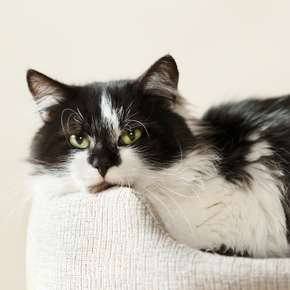
Cats are very inquisitive creatures and often get themselves into trouble as a result. Head Vet Adam Maxton and the team at Bayswater Veterinary Clinic know this only too well having seen many cat emergencies over the years.
It is always better to be prepared for cat emergencies – pop our number in your phone if you don’t have it already. You may want to give it to your neighbours, family, friends, and your holiday cat sitter too if you have one.
Here’s our number: 020 7229 2040
See all our contact information
Dealing with Common Cat Emergencies
According to Adam, some of the most common cat emergencies include:
- Road traffic accidents
- Wounds / bleeding
- Broken bones
- Burns
- Poisoning
- Seizures
- Heatstroke
- Stings
Below is some more information on each cat health problem and what you need to do in the event of an accident.
Cats and road traffic accidents
With many cats spending lots of time outdoors in London, road traffic accidents are always a possibility. Injuries can range from a gentle knock that gives the cat a mild concussion, to more severe broken bones, wounds, or impact to their organs. It is important to ensure that you follow DR ABC’S advice;
- Danger – keep safe from the environment or your pet; a scared dog or any other animal may lash out
- Response – check if your dog is responsive by calling their name
- Airway – is their airway clear?
- Breathing – are they breathing?
- Circulation – do they have a pulse or heartbeat?
- Send – send someone to go and find help
If there is an obvious bleed, you can use clean material and pressure to slow blood loss – read more about this below. Never try to ‘set’ or straighten a broken bone yourself. It is important that any cat suspected of being hit by a vehicle is checked over by a Vet to ensure there is no internal damage or risk of shock from the trauma. Call Bayswater Vets on 020 7229 2040.
Blood loss
Wounds or any bleeds should be treated as a first-aid measure to reduce the amount of blood loss. If they are bleeding use a wound pad, a clean towel, or bandaging to press on the wound to help reduce the amount of blood loss and get them to a Vet straight away. Contact your Vet first to let them prepare for your cat’s arrival and injury needs.
Burns
Burns often occur when cats jump onto hot cooking surfaces; they can also come from freshly tarred roads, surfaces treated with bleach or other chemicals, electrical sources, or being scalded by hot liquids. If your cat has a burn (not chemical), run cold water over it for a minimum of 5 minutes before getting them to the Vet – try placing a damp cloth over the burn and adding cold water, or immersing the burned area in cold water – be careful as most cats don’t like water. Do not apply any creams to the burn and ensure your cat is kept warm and calm to avoid shock. For chemical burns, wear gloves, goggles, and other safety gear and contact our Vets for first aid advice.
Cat poisoning
There are many different poisons that can harm cats with some of the most common being antifreeze, rat poison, paracetamol, and lily plants. If your cat has potentially been poisoned move the item away from them immediately. Always call your Vet straight away and be ready to take your cat there quickly so that treatment can commence without haste. Do not try to make your cat sick as this can make things worse. If they have rolled in something such as oil or have lily pollen on their fur, put a buster collar or shirt over them so that they can’t lick and ingest the poison and try to wipe it off with a damp cloth.
Seizures
Cats can have seizures for many different reasons. If you ever see your cat having a seizure do not pick them up or put anything over the top of them. Turn off any stimulants such as TVs or Radios. Make the room dark and remove anything they may hurt themselves on. Time the seizure and contact our Veterinary team.
Heatstroke and your cat
Heatstroke is common in the summer months, particularly if your cat has managed to become trapped somewhere it is very hot, like a shed or greenhouse. If they are exposed to intense prolonged heat use tepid running water to help cool them down. Do not put any damp towels over them, keep them in a cool area, ensure they have access to plenty of water, and phone the Vet – 020 7229 2040.
Treating insect stings
Again, because of cats’ inquisitive nature, they often end up getting stung. If this has happened, pull (or scrape using a credit card) the sting out and apply either bicarbonate of soda to a bee sting or diluted vinegar to a wasp sting. The area may be very swollen and inflamed so apply an ice pack. If the sting is anywhere near your cat’s eyes, mouth, or throat contact our Vets as any swelling here could potentially close airways.
You will never stop cats from being adventurous and unfortunately, having accidents. Our Vet Adam recommends the best thing you can do is to be prepared – know how to apply basic first aid techniques as described above and always have our number to hand.
Call us in an emergency on 020 7229 2040.
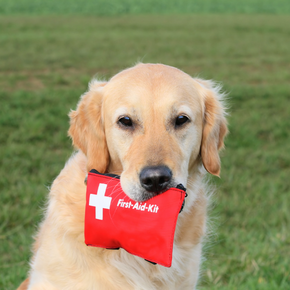
Preparation can mean the difference between life and death in first aid scenarios, according to our Vet, Victoria Seale. This is why the team at Bayswater Vets are recommending that all dog owners in London get themselves a pet first aid kit.
First though, check out our First Aid Tips for Dog Adventures – a guide to recognising conditions that need first aid and immediate veterinary care. Download it via the button below and save it on your phone. You could share it with friends & family by email or on Facebook too.
Download our Dog First Aid Guide
Whilst as owners we should aim to get our pet veterinary care as quickly as possible in an emergency, there are often scenarios where this is problematic. Imagine that your location or circumstances prevent you from getting to the clinic quickly, or your dog’s injury is life threatening and needs an interim measure to protect them before they can travel.
Victoria advises that having a pet first aid kit to hand is crucial in being able to offer vital support when it is needed most. It also gives you piece of mind that you have the tools available to help your pet in the first instance.
Pet first aid supplies – what should your kit contain?
There are many different types of pet first aid kits. How comprehensive yours need to be will depend on what you are doing or where you are. If you are fairly local, you may carry a smaller kit compared to being on a holiday away from local amenities.
Useful pet first aid supplies include:
1.Bandages – different types (first aid courses can teach how to bandage properly)
2.Blunt-ended scissors
3.Wound wash – saline preferable
4.Cotton wool
5.Tweezers
6.Tick removal tools
7.Wound dressing
8.Self-adhesive tape
9.Vinyl gloves / alcohol gel for sanitising hands
10.Foil blanket
11.Thermometer
12.Antiseptic wipes
13.A blanket to use as a stretcher
14.Any medication your pet receives
15.Details for your local Vets – here are ours
16.Details for local vets for the area you are visiting
Having this equipment to hand means you are well prepared for the most common emergencies – download our dog first aid tips to learn what these might be.
Why some of the above items are so important
Victoria explains that different types of bandages can help to stop bleeds, slow down blood loss, or protect a wound whilst transporting your pet. Tweezers can help you remove thorns or stings; never remove any big items that could be going through an artery, and use a special tick removal tool for dog ticks. Gloves and alcohol gel will help to ensure you are clean when cleaning wounds with the saline.
When it comes to blankets, Victoria shares why you need two types in your pet first aid kit. Foil blankets are useful for helping to keep your pet warm and preventing shock after a trauma. Using a blanket as a stretcher is also very important for any injuries to the spine or limbs. If you can carry your pet on a stretcher, they will be more supported and comfortable then carrying them in your arms.
Keeping details of both your Vet practice and a local Vet if you adventuring far from home, will mean you are not frantically searching for the details of an emergency Vet.
Learn your DR ABCS
Whenever faced with an emergency always remember DR ABCS:
·Danger – keep safe from the environment or your pet; a scared dog or any other animal may lash out
·Response – check if your dog is responsive by calling their name
·Airway – is their airway clear?
·Breathing – are they breathing?
·Circulation – do they have a pulse or heartbeat?
·Send – send someone to go and find help
Always ensure wherever you go, no matter how close to home you are, that you carry your pet first aid kit. Also, remember to replace items you have used – there is nothing worse than needing something in an emergency and it not being in your kit!
Victoria’s final piece of advice for dog owners in London, is to learn how to recognise common dog health emergencies – download & share our helpful guide below.
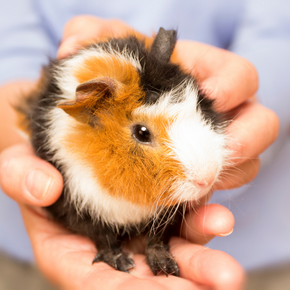
Like any pet, guinea pigs can have health problems that require urgent veterinary attention. As part of National Pet Month, which promotes responsible pet ownership, the clinical team at Bayswater Vets have put together a list of emergency conditions and lifesaving advice for guinea pig owners.
This is not a comprehensive list; it is better to err on the side of caution and phone our Bayswater veterinary surgery for advice if you notice anything of concern with your guinea pig. Any non-descript symptoms such as lethargy, depression, and a decrease in appetite should always be acted on.
Call us if you need us on 020 7229 2040.
See our location & contact information
Life-threatening guinea pig health problems
Gut Stasis
Gut stasis in guinea pigs is a very serious, life-threatening condition caused by other stressful or painful conditions. Common factors include a sudden change in diet or a lack of fibre, an obstruction in the gut, dental disease, traumatic injury, dehydration, boredom, or loneliness. The gut comes to a standstill and the normal passage of food through the gut does not occur.
Symptoms of gut statis include not eating, passing less or no droppings, a bloated or painful abdomen and not wanting to move. This list is not exhaustive, so you should phone our veterinary surgery straight away if you have any concerns on 020 7229 2040. Treatment can include medication to help the gut to move again (unless there is an obstruction in the gut), often pain relief too, alongside fluid therapy and syringe feeding. While this can help to get the gut moving again, any underlying health problems that contributed to the gut stasis will need to be addressed.
Respiratory problems
If you notice your guinea pig has breathing problems, you should phone our Bayswater surgery immediately. They might be breathing more quickly or more laboriously than usual, possibly alongside a discharge from their nose, sneezing, a loss of appetite, and lethargy (amongst other symptoms). Our Vets will carry out a clinical examination and may do further diagnostic tests. There are several things that can cause respiratory problems in guinea pigs including pneumonia, which can be fatal, so early diagnosis and treatment are vital.
Trauma
Like any pet, guinea pigs can suffer from injuries due to trauma. The cause of trauma can be unknown, or due to falling, being dropped by accident when handled, fighting with other guinea pigs, or attacks from larger pets. If you witness any trauma occurring, or you see any signs of injury such as wounds or lameness, you will need prompt guinea pig health care from our Vets – contact us.
Birth
If you have a female guinea pig that you know to be pregnant, or think may be pregnant, it is advisable to monitor her carefully throughout the pregnancy – especially when she is close to giving birth. This is particularly true if she is over seven months of age and has not given birth previously; her pubic symphysis will have fused and so the birth canal will be too narrow for a natural birth. Therefore, a C-section will be needed to ensure the safety of your guinea pig and her pups. There are other potential complications with giving birth so it would be prudent to have a conversation with one of our Vets in advance about what to look out for.
As we mentioned earlier, this is not an exhaustive list of guinea pig health problems and like any pet, acute illnesses can occur at any time – poisoning from plants or food is definitely one to watch out for. The best advice that Bayswater Vets’ clinical team can give guinea pig owners, is to stay vigilant and if you notice anything unusual or concerning, call us.
Call us on 020 7229 2040.

Cats and dogs are naturally inquisitive animals. This has many benefits but can also get them into trouble! A common problem in the spring and summer months is Bee or Wasp stings. Our Head Vet Adam Maxton, has some advice for London owners of cats and dogs on this topic.
To help you tell the difference between bees, wasps, and hornets, our Bayswater vet nurses have put together a handy guide for you to download.
Why do bees sting cats and dogs?
Often in the warmer months we spend more time outdoors and naturally our animals will then spend more time nosing at the flowers. This is typically how cats and dogs get stung as their inquisitive noses disturb the bees and wasps collecting pollen. Trying to catch a buzzing insect can also seem like a fun game…until they get stung!
Signs that your cat or dog has been stung
In most cases, owners will not actually see the stinging occur. Instead, you may see your pet suddenly shaking or pawing at their head or body, or they have a swollen face all of a sudden.
Typical bee and wasp sting symptoms include:
- Swelling (often around the muzzle where they have been sticking their nose in)
- Constantly licking either at a specific area or their lips if the sting is inside the mouth
- Redness around the area where the sting went in
- Pawing at the area
- Vocalising more than usual
Severe symptoms could include:
- Breathing difficulties, especially in brachycephalic breeds if the sting is around the throat area
- Vomiting and diarrhoea
- Allergic reaction such as anaphylactic shock (although this would be very rare)
How to treat a bee or wasp sting on a cat or dog
Unless you saw the stinging occur, it will be difficult to tell if your pet was stung by a wasp or a bee. Either way, you can use our first aid tips below.
First, you want to make sure the sting is removed. Our Bayswater vet nurses suggest using something flat like a credit card to scrape the sting off your pet’s skin and dispose of it. Avoid using tweezers to pull the sting out as they could squeeze venom into your pet.
Second, if you do know whether it was a bee or a wasp, you could apply the correct substance to soothe the pain;
- Wasp = vinegar/lemon juice
- Bee = bicarbonate of soda & water paste
Do you know the difference between a bee and a wasp? Download our Know Your Insects Guide
If you do not know the culprit, or after you have used the above first aid advice, you can then apply a cold pack to the swelling.
When to call a Vet
If you are at all concerned, especially if the swelling is causing further distress to your pet or is likely to affect an airway, you should always ring a Vet for advice. Our Alexander Street veterinary team are here to help, just give us a call on 020 7229 2040.
Some pets may need pain medication, which can be prescribed by one of our Vets too.
London pet owners sometimes ask if they can use antihistamines to help with the reaction; these can only be prescribed by the Vet to ensure the correct dosage is given, and because some ingredients could possibly be fatal in some brands.
Just to be safe this season, why not print our Know Your Insect guide and stick it on your fridge to help you spot the differences between bees, wasps, and hornets?
Remember to share this advice with your pet-loving friends on Facebook!
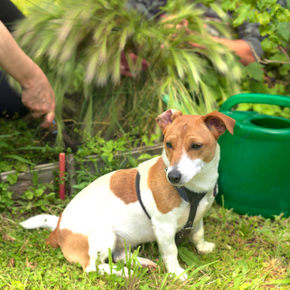
Spring is the ideal time to spruce up your garden after a gloomy winter. It is also your chance to garden with your pets in mind, so you can have a pet-friendly space all year round.
The team at Bayswater Veterinary Clinic have collated some important ideas below to help London pet owners make their garden a safe space for their four-legged friends. With our no-fuss guide, you can pet-proof your garden and keep your dogs, cats, or rabbits happy and healthy all year long.
Plants are an integral part of many gardens but some can be harmful, even deadly. Our Bayswater Vets have also put together this helpful guide to highlight the signs to look out for, what to do if you suspect poisoning, and common toxic plants. You can download our guide here:
Get our Poisonous Plants guide
Pet-proofing your garden is mostly about making it safe for exploration. Look at your garden as a whole and imagine your pet exploring it. Remember, animals are curious and mostly led by smell, so if your dog, cat, or rabbit can physically reach somewhere, it is not ‘off limits’ to them.
Below is a comprehensive list of ways to make your garden safe. Adopting these strategies to pet-proof your garden now will make life easier later and ensure your pets have a safe outdoor space to enjoy all year long.
How to pet proof your garden
Bayswater Vets’ team suggests your to-do-list should include:
- Pet proof your garden fence and fix any gaps in boundaries where your pet could escape through.
- Get rid of broken bottles, sharp stones, and other obvious hazards.
- Tidy away tools and anything you do not want your pet ‘playing’ with or nibbling.
- Relocate or reorganise piles of bricks or wood so they can’t topple over.
- Make places your pet could get trapped inside or under inaccessible and close shed doors.
- Fence off areas your pet could fall from and any bodies of water.
- Put harmful substances on high shelves and behind cupboard doors.
- Choose pet-safe plants and remove toxic plants for pets – remember that parts of plants can be spread throughout your garden by wildlife and wind.
- Remove/relocate bulbs that could harm pets – cover soil in netting so pets can’t dig them up.
- Grow vegetables in raised beds – put netting over to keep out curious paws and noses.
- Only use pet-safe products to repel insects, slugs, and snails.
- Don’t leave pet bowls and toys out overnight – slugs/snails can cause lungworm in dogs.
- Lawns: beware as grass seeds can get lodged in eyes and cut grass is toxic when eaten.
- Clean up any animal faeces (not just your pet’s) to avoid your pet eating it and becoming unwell or potentially contracting worms.
- Remember that wildlife frequents your garden too and may drop food that contains bones, raw meat, raisons, or other toxic ingredients – check your garden before letting your pet out.
- And finally, monitor your pet’s time outside. Head Vet Adam Maxton cannot stress this enough – accidents and escape attempts can happen fast.
If you have followed this list, your garden should be a safe and happy place for your pet to hang out in. You could go a step further by creating dedicated areas in your garden for digging, playing, relaxing, and toileting of course, maybe even connected by a pet-friendly garden path. This creates a harmonious outdoor space that works for you and your pets.
Remember to download our Pet Plant Poisons Guide below. Also, why not share our article on pet-proofing your garden with your pet-loving friends and family on Facebook or email?
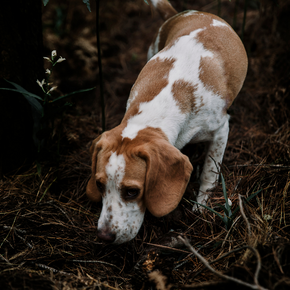
What do dog fleas look like? Could my dog have worms? Why are ticks so dangerous? These are just some of the questions we get asked by London dog owners at our Bayswater vet practice.
In this article, our Head Vet Victoria Seale invites all dog owners to take a closer look at common dog parasites as we head into spring. Victoria shares what you need to know about dog fleas, worms, and ticks below, and you can download our handy infographic highlighting the common signs to look out for here:
Get our Spotting Pesky Parasites guide
Dog fleas
As well as making your dog feel itchy, sore, and uncomfortable, fleas pose a serious health risk. They lay flea eggs on dogs and in your home, multiplying rapidly. A flea infestation can lead to anaemia (due to the volume of blood they consume), which can be fatal especially in puppies or unwell dogs.
Victoria advises owners that fleas do not spend all their time on pets. Fleas can also survive in cracks and crevices, on furniture, and in carpets for up to a year. If your dog gets fleas you will need to treat them, your home, and other pets – never share flea treatments between pet species.
How do dogs get fleas?
Fleas are common in the environment and can be easily picked up in the garden, on walks, and from other pets carrying them. The only way to avoid your dog getting fleas is to treat them (and cats if you have them) regularly throughout the year with vet-recommended preventative flea treatments. One-off treatments might remove existing fleas but won’t protect your pets going forward, neither will many over-the-counter products.
What do dog fleas look like?
Dog fleas are small, black/brown in colour, and swell after feasting on blood. You can sometimes spot them crawling or jumping on your dog, or you. To help you spot other tell-tale signs of fleas, get Victoria’s dog parasite guide here.
Dog worms
To give your dog ongoing protection throughout their life, they will need a vet-recommended worming treatment every 1-6 months, depending on your Vet’s guidance. Some worms can have devastating consequences for your dog, and some can be passed to humans, so Victoria stresses the importance of preventative worm treatments.
- Roundworms: higher risk to younger dogs – can be passed to humans
- Tapeworms: exposure risk higher in dogs who scavenge for food and those with fleas – children at risk of contracting from infected faeces
- Hookworm & whipworm: like tapeworms, these are common intestinal worms that can cause health complications
- Lungworm: often fatal, picked up from the slime of infected slugs and snails – increased risk if dog toys and food/water bowls are left out overnight
- Heartworm: dogs travelling abroad can be at risk
To help you spot the tell-tale signs of dog worms, download our parasite guide here.
Ticks
Ticks mostly live in woodland, long grasses, and fields where livestock or deer graze. Although most prevalent in spring and summer, they can be problematic throughout the year in some areas.
Ticks are usually small, oval, and flat in appearance, about the size of a sesame seed. They can swell to the size of a coffee bean after a feast of blood. Victoria advises dog owners to check for small lumps on their dog’s skin (and their own) after walks.
Why are ticks so dangerous?
Ticks latch on by inserting their mouthparts into the skin to suck blood. A tick bite can cause irritation, anaemia, and temporary paralysis in rare cases. Ticks can also spread Lyme disease, which affects humans too and can lead to a serious, debilitating chronic illness with complications for life.
How do you remove a tick safely?
It is important to use a special tick removal tool in a twist and pull motion instead of pulling a tick straight out, which could leave the head in and increase the risk of disease transmission. Ask our team about tick removal tools.
With pets being outside more in spring they are more at risk of picking up parasites. To help you spot the signs of tick bites in dogs as well as worms and fleas, check out Victoria’s handy dog parasite guide:
If you found our article on dog parasites useful, why not share it with your dog-owning friends and family by email, WhatsApp, messenger or on Facebook?
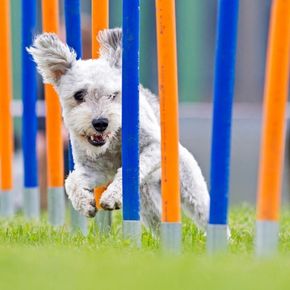
Nutrition and exercise go hand in hand when you are trying to lose weight or just live more healthily. At Bayswater Veterinary Clinic in Bayswater, we love dogs, and we love helping owners improve their dog’s health and happiness. Our team have put together some proactive dog nutrition and exercise tips to help you make a plan.
You can help other dog owners in London by sharing your dog wellness tips on our Facebook page:
10 top tips for creating a dog nutrition & fitness plan
- Choose a good quality, nutritionally complete, dry dog food that will support your dog’s health, life-stage, activity levels, and dental health.
- Some owners like to add wet food, look for one with good quality ingredients.
- Measure/weigh your dog’s food portions to ensure they are getting the right amount for their daily needs. Remember that more exercise may need more food. Ask us if you are unsure.
- Ensure your dog drinks plenty of water, you can always put some in with their food.
- Reduce treats and switch to healthier options like carrots and cooked green beans.
- Write down the exercises you want your dog to do and when, so you have a clear guide to keep you bothon track.
- Even if weight loss isn’t the focus, it is a good idea to write down weight goals (lose/gain/maintain) and measure changes every 2 – 4 weeks. This way, you can adjust the exercises or nutrition quickly if any issues arise. Pop into our Alexander Street practice to get your dog’s starting weight. We can also do a body condition score to understand where your dog is at on the scale – just request a Nurse appointment.
- Increase the time, speed, and/or incline of your dog’s daily walk to burn more calories, give muscles more of a workout, and mix-up their regular routine.
- Try something new like dog agility if your dog is up to the challenge – be careful with older dogs and take it slow to start with.
- Consider a dog fitness app that lets you track routes, activities, and achievements.
Now you are ready to create your dog’s ‘healthier in 2022’ plan.
Don’t forget to make time for rest and recovery in your plan to avoid injury, burnout, or loss of interest for you both. Dogs do need daily exercise, so it is a good idea to do standard walks on some days (or all days if you have a very energetic dog) and try something more up-tempo on others. We hope you enjoy your new plan as much as your dog will!
Call us if you would like more advice or to book a body condition score appointment with our Vet Nurses on 020 7229 2040.
Help your friends and family, and other London dog owners by either sharing our article on your social media profiles or,

Did you know that guinea pig grooming has many benefits for both short and long-haired breeds? It’s not just about detangling and de-matting those long locks! Bayswater Vets’ Nurses have some advice on why you should, and how to groom your guinea pig.
We always love hearing from our clients and the wider guinea pig owning community. Head over to our Facebook page and ask us any grooming and small furry pet questions and we’ll be happy to help. Ask us questions on Facebook.
Why do guinea pigs need to be groomed?
Guinea pigs usually do a great job of grooming themselves to get clean. However, there are many benefits that come with regular grooming by their favourite human, such as:
- Keeping your guinea pig free from tangles and dirt
- Checking for skin lumps and bumps, hair loss, dental problems, and pests
- Bonding time with your tiny companion
- Help staying clean if they are elderly or unwell
How to groom your guinea pig
If you are wondering how often you need to groom your guinea pig and what’s involved, our Bayswater nursing team have some helpful advice for you below.
- Short-haired guinea pig breeds like the American Cavy only need brushing once a week to minimise shedding and keep them clean. Any more could result in loss of hair density and quality.
- Long-haired guinea pig breeds such as Peruvians and Abyssinians generally need brushing 2-3 times a week to prevent matting and dirt build-up, which can lead to infection and parasitic ‘invasion’.
Depending on your pet’s breed and hair type, you can use the palm of your hand (add water if your guinea pig is shedding) or a metal narrow-toothed pet-flea comb. Be gentle, and brush in the same direction as your pet’s hair grows.
Not all guinea pigs will enjoy being brushed, however, it is an essential part of keeping them healthy. Try altering the frequency to avoid stressing them out. You could also gently stroke them from head to toe whilst brushing and feeling for anything unusual.
There is a little more to guinea pig grooming than just brushing – they will also need:
- Monthly or bi-monthly nail trims
- An occasional ‘butt’ bath
- Weekly dental check & ear clean
- Regular grease gland ‘clean-up’
Learn more about each of these tasks in our handy downloadable guide.
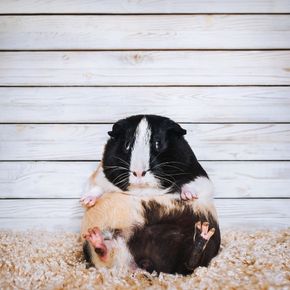
The New Year is typically a time for change, making now the perfect time to change your pet’s life for the better if they are overweight. The team at Bayswater Veterinary Clinic love helping owners and have this advice about overweight guinea pigs.
Contact us to book a weight check
Reasons for an overweight guinea pig
When it comes to guinea pigs and other small furry pets, weight gain is usually (and we hate to say this but…) because as owners, we haven’t provided them with the right type or amount of food, exercise and mental stimulation.
There are other reasons guinea pigs can gain and lose weight so it’s always wise to get your pet checked out by a vet as soon as you notice a change.
- Weight gain (or loss) over a few days or weeks could be a sign of a medical condition, most commonly a tumour or pregnancy.
- Weight gain over a few hours could be an emergency condition called ‘bloat’, which is a distension of the abdomen – contact us immediately if this is the case.
Head Vet, Adam Maxton, at our practice in Bayswater explains why carrying excess weight is a BIG problem for small pets.
Overweight guinea pigs are:
- less able to reach their rear-end to clean it, which amplifies the risk of flystrike (often fatal)
- putting more strain on joints leading to painful movement
- less mobile and agile, affecting their everyday quality of life and ability to exercise
- candidates for diabetes, typically if fed a high-carb diet with lots of fruit & sugary treats
- at increased risk of complications if pregnant
Assuming all is well, right now is the ideal time to help your small pet shift excess fat.
Helping your guinea pig lose weight
First, we recommend booking a weight check at our Bayswater practice. Our nurses will assess your guinea pig’s weight, and tell you how much they need to lose.
Our team can then also give you advice on how to:
- review your guinea pig’s diet – provide the essentials and give healthier treats.
- experiment with different ways of feeding – bowl vs scatter feeding and foraging trays.
- provide sufficient mental stimulation & physical exercise through pet companionship, suitable housing, stimulating activities & items, and time outside their enclosure.
Let our nurses help you get your guinea pig on the right track and book a weight check at our Bayswater veterinary practice – see our location and book.

We’re sure many small furry pet owners in London can relate to this; how do you avoid having a bored guinea pig or a bored hamster?
This can be especially tricky when you’re burning the Christmas candle at both ends and struggling to dedicate as much time as usual to your little pal. Our head Vet Victoria Seale, and their team have scoured the internet and come up with some interesting looking, highly rated toys for your small pets to try. We’d love to know what you think so share a photo or video on our Facebook page.
Share your pet’s fun times on Facebook
Most small pets (excluding Syrian hamsters) prefer to live in pairs, so it’s important to give them a companion to avoid loneliness. When they get bored, they can become depressed and some will even self-mutilate so mental stimulation is important too.
If you notice anything unusual about your pet, book a small pet Vet check.
To avoid boredom, small pets need toys and activities that allow them to mimic their natural wild behaviours like exploring, foraging, and gnawing. We hope you like the look of these too:
Eight boredom busting toys for small pets
Wooden Exercise Wheel – This might end up with some teeth marks in, but your pet will have enjoyed themselves.
<external link="" to:="" Play Tunnel Giant Tube – Depending on where you hang it from, your pet can have lots of fun jumping in and out of it.
Natural Grass Hammock – Chewable, swingable… what’s not to love?
Boredom Breaking Chew Toys – Get 11 toys designed for hamsters, rats, guinea pigs, chinchillas, gerbils, rabbits, and Syrian hamsters – so much choice!
Floral Hanging Basket – This is ready to be chewed and delightfully destroyed.
Carrot Cottage – A cute cottage covered in hay with a real carrot roof? Yes, this is perfect for climbing on, sleeping under, and gnawing.
Peanut Gnawing Chew – These hamster chew toys will be good for boredom and filing down their teeth, plus they’ll work with most small pets.
Fruit Flavoured Nibble Cage Chew – Another tasty treat that’s ideal for oral health and preventing boredom.
If you’re on a tight budget this Christmas or just enjoy making things yourself, check out these videos on how to make DIY toys for guinea pigs, hamsters, and other small pets:
How to make a foraging box for guinea pigs
Make boredom busting toys for hamsters and other small pets
10 DIY toys for rabbits and other small pets
We’d love to see how your small pets get on with any of these toys, or if you have your own. Visit our Facebook page and share your photos and experiences!




